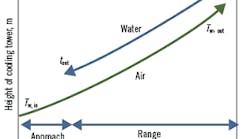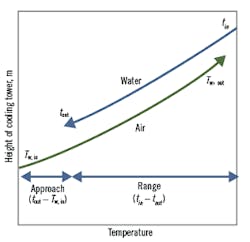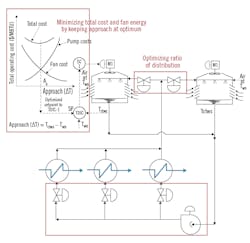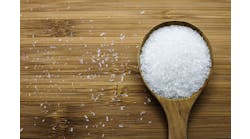Cooling tower safety vs optimization: The operational and safety aspects of cooling towers
This will be a two-part series. Here, we describe the operational and safety aspects of cooling towers. The next column will discuss their control and optimization.
Cooling towers (CT) are water-to-air heat exchangers, used to discharge the waste heat from processes into the atmosphere. They vary in size from small roof-top units to very large hyperboloid structures that can be as large as 200 m (660 ft) tall and 100 m (330 ft) in diameter, or can be rectangular structures that can be more than 40 m (130 ft) tall and 80 m (260 ft) long.
When functioning properly, they serve the safety of the plants, while their failure can cause serious accidents due to overheating. Their cost of operation is the sum of the water and air transportation costs, and therefore, if these costs are minimized (optimized), the operating cost of the plant can be reduced a fair amount. (In an IBM job, we reduced the plant operating cost by 17% through optimization.)
This article describes both the levels of safety (reliability) that different cooling tower designs can provide, and the control systems that can reduce their cost of operation through optimization.
Cooling tower terminology and operation
All cooling towers take advantage of the chimney effect, which moves the outside air through the tower. The air movement caused by the chimney effect depends on the difference in density between the entering colder outside air at the bottom and the air inside, which is lighter because it is warmer and more humid. The humidity of the air increases as the air rises in the column because water keeps evaporating as long as its temperature is above the wet-bulb temperature of the air. This evaporation lowers the density of the inside air and also causes some loss in the circulated water, which requires makeup. As the heat of the water is transferred to the air, the lower-density inner air rises and draws in the fresh air at the base of the tower.
Figure 1: The Approach is reduced if either the tower capacity (heat transfer area) or the airflow through the tower is increased, and it is decreased if the water flow is decreased. The Range is the difference between the temperature of the returning hot water from the process (Tin) and the temperature of the cooled water supply to the plant (Tout).
In natural draft towers, the air flow is caused only by the "chimney effect," while in mechanical draft towers, the air flow is amplified by fans, which are either at the top of the tower and pulling the air (induced fan towers) or are at the bottom, pushing the air (forced fan towers) through the column.The temperature of the water supplied to the plant by the cooling towers (Tout) is always higher than the wet-bulb temperature (Tw) of the air that cools it. If a thermometer bulb is covered by a wet, water-absorbing substance and is exposed to air, evaporation will cool the bulb to the wet-bulb temperature of the surrounding air. This is the temperature read by a psychrometer. If the air is saturated with water, the wet-bulb, dry-bulb and dewpoint temperatures will all be the same. Otherwise, the wet-bulb temperature is higher than the dewpoint temperature but lower than the dry-bulb temperature.
Tout can only "approach" Tw, but can't reach it. This approach (A = Tout - Tw) is reduced if either the tower capacity (heat transfer area) or the airflow through the tower is increased, and it's decreased if the water flow is decreased. The range (R = Tin - Tout) of the CT is the difference between the temperature of the returning hot water from the process (Tin) and the temperature of the cooled water supply to the plant (Tout). These terms are illustrated by Figure 1.
CTs are more efficient in the winter (about 80%) and less efficient in the summer (about 65%), and also less efficient in high-humidity regions. The efficiency of CTs is calculated as 100 times the ratio of their range divided by the sum of their range plus approach:
µ = 100 (Tin - Tout) / (Tin - Tw)
The temperature difference between their inlet and outlet water temperatures is normally 10-15 °F. The water consumption is about 1% for each 10°F of water cooling.
Cooling system safety
The safety of all cooling systems increases as the number of their components is reduced. The proper operation of conventional industrial cooling tower systems depends on the availability and proper functioning of the air transportation devices (fans) and the water transportation devices (pumps). From a safety perspective, the most important factor is the availability of the power supply to these components. Naturally, safety can be improved by backup (diesel, battery, turbine, etc.) power sources, but as we've seen in many accidents, backups can also fail.
The more components a cooling system has, the less safe it is. From that perspective, the least safe cooling system is one that uses chilled water. There, the process heat is first transferred to the chilled water, then it’s moved from the chilled water to the cooling tower water, and finally, it’s transferred to the air. It is the least safe because it consists of four components (chilled water pumps, chillers, cooling tower water pumps and cooling tower fans), each of which can potentially fail or lose its power supply.
Consequently, the safety of the plant will be increased if the process can be redesigned to operate directly with CT water, so the chiller can be eliminated. On the other hand, if the cold water generated by the tower is not cold enough, it has to be sent to a chiller for further cooling before it's sent to cool the process. The safety and optimization controls of chilled cooling systems were discussed in detail in “Optimization of cooling systems.”
The direct use of cooling tower water makes the plant safer because its operation requires the proper functioning of only two components, the CT fans and pumps. These cooling towers are most widely used in industry. If their fans are variable-speed, their cooling capacity becomes variable because the temperature of the water they generate can be controlled by adjusting the speed of the fans (continuously or intermittently).
The reliability of a cooling system can be further increased by reducing the number of operating components in the system to one (the pumps). This is the case with natural draft cooling towers that use no fans. Natural draft (hyperboloid) cooling towers are often used where maximum safety is required, such as in nuclear power plants. They are very large, tall hyperbolic chimneys, shaped like a nozzle. This allows cool, dense, outside air from the environment to naturally flow up through the bottom of the tower and out through the top. That flow of air is what drives the evaporation of the water being cooled.
The advantages of natural draft towers include suitability for high-load and high-water-flow applications, reliability, consistent performance and low maintenance. On the other hand, their capital cost is high, they are not suited for high dry-bulb temperature applications, they can't approach the wet-bulb temperature very closely or provide close temperature control, and their efficiency is lower, and dependent on wind forces and aging. They also require good cleaning against pathogenic bacteria causing Legionnaires disease.
The safest and most reliable cooling system is one that requires no man-made power source at all because it's self actuated, using the always available natural energy sources of gravity and thermal expansion. Such a cooling system is a concept only (it doesn't exist anywhere), and I described it in my article dealing with safe nuclear.
Part 2 will discuss the control and optimization of cooling towers. Figure 2 shows the control loops that will be discussed in Part 2.
Figure 2: Total cost and fan energy, distribution and pumping energy are the three control loops that will be discussed in Part 2.








